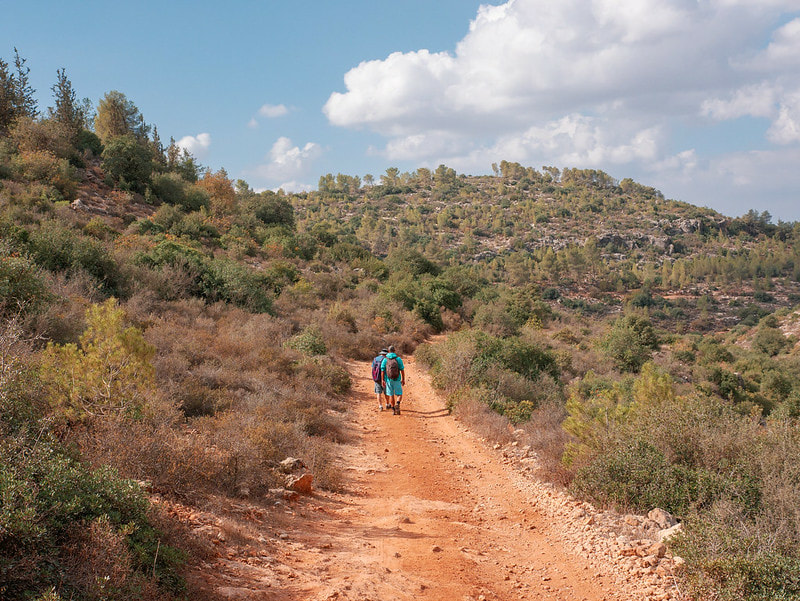|
The picture above shows two modern travelers making their way through some rough, desert-like terrain. If you imagine them in long robes and squint a bit, this is probably pretty close to how the two disciples looked, as they made their way to Emmaus. This Biblical story has been on my mind lately, since it was one of the Mass readings this week, post Easter.
The big question that everyone always asks about the Emmaus story is "Why didn't the two disciples recognize Jesus?" I once heard a well known Scripture scholar ask this exact question at a conference. She was giving the keynote address, and I thought she had many wise and true insights to share. But, she mentioned that the disciples' lack of ability to recognize Jesus had always bothered her. After all, they had spent a few years with Jesus. How could they not recongize someone they had spent so much time with? Was he that changed, after the resurrection? Her answer was to say that the disciples simply could not recognize Jesus because they couldn't fathom the possibility of the resurrection. I think that could certainly be true. I've heard other folk say that the disciples didn't recognize Jesus because he was so transformed in glory he was impossible to recognize. I think the answer is more simple that that. After his resurrection, whenever Jesus IS recognized, it is almost always in the breaking of the bread. In fact, I like to read the Emmaus story out loud to the families at our sessions and I stop at verse 31: And it happened that, while he was with them at table, he took bread, said the blessing, broke it, and gave it to them. With that their eyes were opened and they recognized him, but he vanished from their sight. (Luke 24: 30-31). "Where did Jesus go?" I ask. "I'll give you a hint. He is still in the room." I love to watch the young children especially. They turn to mom or dad, eyes wide, and say "Where is he?" The answer is pretty obvious, once it's pointed out. Jesus has not left. He is now fully present in the form of bread and wine, just as we proclaim at every Mass. It seems, then, that the reason the two disciples didn't recognize Jesus on the road to Emmaus is that, post resurrection, Jesus will be fully present sacramentally. He is no longer only Jesus of Nazareth, the wandering preacher with a small band of followers, even though we understand he has always been the Son of God. Jesus has changed from being confined to a single place and point in time (i.e. a very small and local area of Judea, circa 33AD) to being able to go everywhere and all times, carried through time and space by his diciples, who become moving temples. Yes, this form is unexpected, especially to those of us outside of Judaism since we don't have the tradition of the Passover meal handed down, generation to generation. And certainly, it was completely unexpected. But, it also makes sense if you follow all the other covenants that God made in the Old Testament. In fact, the divinization of that little bit of wheat and those few grapes points to the ultimate end of the entire universe, when God will be "all in all" and those who follow in the path of discipleship will enter the Kingdom of God. It's a lot to take in, really. I like to say it's "profoundly simple." Something to ponder, this Easter season.
0 Comments
 Happy Easter! The long journey of Lent is behind us. Now is the time to rejoice! In keeping with the celebration of Easter, today I begin the series on works by Marjolein Bastin, an internationally acclaimed artist who is renowned for her ability to capture nature scenes in an uplifting and inspiring way. Since it is the day after Easter Sunday, it seemed appropriate to start off with a post on an ornament done for Hallmark in 2004, called "Thirsty Cardinal." This ornament is particulary fitting to think about at this time of the year. On Good Friday, just 3 short days ago, we hear the words uttered by Christ on the cross "I thirst." In her now famous vision on the train, Mother Teresa hears these words spoken to her by Jesus and she immediately understood them to mean that Jesus thirsts for souls. These words and this understanding became her motivating guidance through the decades of service she offered to God and the world. She went in search of souls for Christ. |
The BlogDisclaimer:
The images on this website are either my own or are used under the Creative Commons license. No images have been edited, shared, or adapted. A link to each work that I do not own is provided at the bottom of the page. CC License: Archives
March 2024
Categories
All
|




 RSS Feed
RSS Feed
